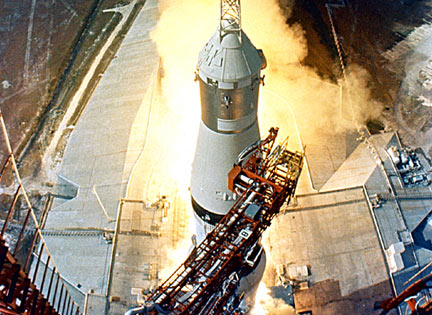Neil Armstrong lands at Lotusphere

IBM gave attendees at this week's Lotusphere conference an unexpected treat — a speech from Neil Armstrong on the role technology played in the race to the moon.
Armstrong is a living legend, famous for uttering "That's one small step for man" as he set foot on the moon in 1969. On Monday, he told delegates at IBM's Lotusphere conference in Florida a few tales about the early computers he worked with.
He also cited IBM's contribution to the space programme, by explaining the company's role in the Gemini spacecrafts — in which Armstrong made a trip into space in 1966.
"Gemini was the first manned spacecraft to carry a computer into space. Built by IBM, it didn't have four gigs or four megs [of memory], but just four K [kilobytes]. It is hard to realise just how precious memory was in those days," Armstrong said.
"The computer had 13 keys on the keyboard and its sole output was one seven-digit register, just number, no letters, no sound, no mouse. But it allowed us to compute solutions that we had thought impossible," Armstrong explained, marvelling at the power that such a basic machine — in today's terms — could achieve.
"Changing orbits, rendezvousing with another spacecraft, returning to earth to a pre-determined landing spot, all with a primitive, little, 4K machine."
Armstrong's first flight in a rocket plane came when he worked as a test pilot on the Bell X1-B, a derivative of the world's first supersonic plane, the X-1. Armstrong had his first experience with computer technology at that stage, although not computers as we know them today.
"Except for the WWII link trainer, aircraft simulators for training did not exist," said Armstrong, "but they were beginning to be used as a flight test tool". As digital computers were "far too slow to solve aircraft equations of motion in real time", flight simulation, what there was of it, "was dependent on analogue computers. Lightning fast, but not very accurate".
Armstrong's first real space experience came with Gemini. This was the first spacecraft with onboard navigation and guidance, he said, and the basis for the complex computer systems that control the flight of aircraft today.
"Earlier crews navigated by looking out of the window," Armstrong said. "Gemini was the first spacecraft with navigation and that meant adjusting [guidance] and it was the first with radar, the ability to rendezvous with another craft. Gemini was a wonderful little machine and with it I was able to rendezvous with another satellite and make the first two spacecraft dock."
Navigation error
But while the early primitive systems were of enormous benefit to astronauts such as Armstrong, they were anything but infallible.
"In those days we landed in the ocean by parachute, not a particularly elegant arrival and we hoped there would be a ship nearby to pick us up," Armstrong explained with the deadpan look of a man who knows the twist at the end of the tale. "With our navigation system that we now had, we took great pride in landing close to the aircraft carrier. My carrier was located in the Caribbean, I landed near Okinawa."
The error was significant to the mission and made the record books. "That's the furthest anyone has ever been [missed] and I don't expect the record to be broken," Armstrong admitted.

Apollo 11 taking off in 1969 on the mission that would take Neil Armstrong and Buzz Aldrin to the moon